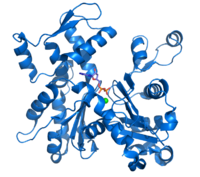
Photo from wikipedia
Inhibition of Tau protein aggregation is an attractive therapeutic target for Alzheimer's disease. However, most of the inhibitors have failed in clinical trials due to the superficial understanding of inhibition… Click to show full abstract
Inhibition of Tau protein aggregation is an attractive therapeutic target for Alzheimer's disease. However, most of the inhibitors have failed in clinical trials due to the superficial understanding of inhibition mechanism and drug-transfer pharmacokinetics. Innovation of design strategy has become a top priority. To afford a hairpinlike molecular inhibitor, we introduced tannic acid, a multibranched polyphenol molecule, and its moiety, gallic acid. We showed that tannic acid could effectively inhibit Tau aggregation through a multidentate chelation mode. We then encapsulated tannic acid in a non-neurotoxic liposome by lecithin/β-sitosterol, overcoating with Tween 80. Using transwell devices, we cytologically demonstrated that tannic acid liposome can successfully be transferred across the model of a blood-brain barrier made up of mouse brain microvascular endothelial cell bEnd.3 and effectively reduce Tau aggregation induced by fibrils of Tau peptide R3 in human neuroblastoma cell SK-N-SH. This result indicates the potential therapeutic effect of tannic acid liposome on Alzheimer's disease.
Journal Title: ACS chemical neuroscience
Year Published: 2020
Link to full text (if available)
Share on Social Media: Sign Up to like & get
recommendations!